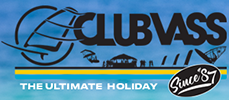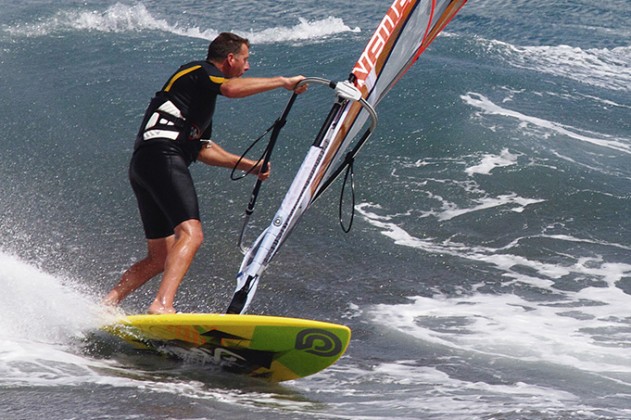IDENTITY CRISIS?
As you’re reading this we’d wager a guess that you’re either (a) of heavier build and wanting a dedicated wave board, (b) not sure if you should buy a wave board or a freestyle-wave, or (c) a lighter rider looking to extend your wind range and find a sweet-turning board for lighter wind?
Back-in-the-day, you would’ve been hard-pushed to find a dedicated wave board with more than 90-something litres. Now they’re pumping them out in sizes around the 120-litre mark. Surely this is the domain of the Freestyle-Wave (FSW) board we hear you cry? Isn’t this a ‘dedicated wave board test?’
Yes, it is. And it’s also true larger wave and FSW boards turn much better now. Mainly due to compact outlines helping them fit in-the-pocket more, something that’s opening the eyes of smaller windsurfers, as well as giants.
But are these two types of board the same thing and, if so, why do brands sell multi-finned versions of both? More importantly then, exactly which category most suits you best – or is there something halfway between the two? A dedicated wave board for the, err, less dedicated if you like?
In this group we found a bit of both. Some hard-core, go-anywhere, versatile beauties and some that are like FSWs – but just not really that suitable for the ‘freestyle’ element. Perfect if you’re undecided whether to buy a FSW or a waveboard then.
QUALITY VS. QUANTITY
Today’s bigger wave boards have also got flatter and faster rocker lines that aid earlier planing. But exactly how ‘dedicated’ are they? And what elements of ‘sailability’ – if any – do you have compromise on to be able to radically rip apart a wave?
That ‘sailability’ factor is a moot point. Would you prefer to catch two quality waves-per-hour on no-compromise gear – or snag 20-per-hour on some not-so-hard-core equipment?
In this gaggle of gear there’s ‘something for everyone’ in that respect. If you look at the ‘scale’ further on (print version only) you’ll see a few in the middle that are close to being jacks-of-all-trades, with some slight variances in suitability for different builds of pilot or types of conditions – more of which you’ll glean from the individual reports.
TEST CONDITIONS
With a fortnight in El Medano we were faced with some really marginal conditions and a few banging windy days – mostly in pretty small weak surf – with nearly all of it served with onshore wind. Perfect for testing the ‘real world’ capability of the selection.
As much as we’d have liked a week of down-the-line riding, the truth is, in these conditions you find out a lot more about the gear’s ability to turn – and, if it turns here, it’s unlikely to go all stiff at Ho’okipa. Plus of course we’re talking about similar conditions to the average setups people sail in at home.
Tenerife also has the Harbour Wall that is sometimes more sideshore and open to groundswell, like the south pulse we gladly received during the PWA event week, which gave the opportunity to test them out in some faster and larger waves.
These 95s were mostly powered using the 5.3 wave sails that are also reviewed in this [October] issue as well as on the 4.7s due to be published in the upcoming edition – and even a bunch of 4.2s!
THEY DON’T SUCK
So, what have we got here? Two ‘single thruster’ shapes (JPAustralia and Fanatic), one dedicated thruster-that-can-go-single (Witchcraft), A five-finbox quad/single/tri/twin offering from Tabou, two quads (Quatro and Goya) – and a twin-that-can-go-single from Starboard.
That’s a lot of fins and combos. When multifins first re-appeared on the scene, the most striking initial characteristic we all first noticed was that they had less upward lift than our old singlefins. ‘Planted’ some people called the sailing sensation.
Well, despite the mind-numbing permutations here, we all felt this current crop all had nice ‘singlefin-esque’ lift and felt hardly any ‘suck’ down towards the water. Perhaps it’s rocker lines becoming straighter? (Likely.) Maybe it’s the upward, drivy nature of many modern wave rigs?
The bottom line is, in these conditions, we didn’t really notice – or care – what configuration we had under our feet, because so much of each board’s behaviour seemed to be determined largely by shape.
INSTANT GRATIFICATION
While many of us gear-heads love a bit of tinkering and tweaking to tune our gear to the day’s conditions, perhaps more are lazy, not bothered or plain uninterested in enhancing our setups – especially when it’s windy and you just want to get out there!
On board tests we usually agree a suitable ‘spread’ of stance to suit a range of tester builds and the scope-of-use. We also place the mast tracks in the middle. (Regardless that this varies in distance from the tail from board-to-board. Our reasoning is that if the brand has deemed this track position then we should find it’s all-round best placement in the middle of that track, be it more or less than say 130 cm from the tail or other ‘standards’.)
For this ‘dedicated wave board test’ we opted for the widest stance range as our starting point and noticed some interesting results. With two tall guys and a less vertically inclined person spanning a weight variation of 20 or so kilos, it was worth noting that the boards we all liked in common were the ones that seemed to require very little adjustment of either stance or track. By contrast, the ones that needed more work and adjustment to suit the conditions, never quite seemed to hit the mark.
RAIL AND TAIL
One final issue to point out as you weigh-up your personal choices was that within this group there was a notable variation in both rail profile and tail thickness. None of these products have massively wide tails, which is generally a positive thing in relation to wave riding. Of course width can bring early planing benefits, but that broader tail can also limit turning ability – especially if accompanied by excess rail thickness.
To compensate for lack of width, some have more volume in the tail – this helps with pop for jumping too. But too much volume can lead to awkwardly thick rails that also limit sharp and precise turning.
Here’s some perspective on the range within this group:
Tabou Da Curve: the thinnest width under your back heel and arguably the most dedicated hard-core riding board.
Witchcraft Chakra 95: the widest under the back strap but the thinnest rails on test – so a good carver – and also the earliest planer – yet not the best at jumping.
Fanatic Triwave: joint second widest under rear foot (with Quatro) AND the thickest rails, hence it’s early-planing and jumping ability, but explaining it’s easy tail-sliding prowess rather than precise, full-rail slashing nature.
Starboard Kode: second narrowest tail but a good balance between tail volume and narrow tail edge, so awesome for jumping and hooked turns, but impressive early-planing due to the width-further-back outline in comparison to the mainly teardrop profiles in the group. (‘Hips’ vs. ‘Shoulders’!).
Our advice is to bear these combinations in mind when assessing your needs, dependant on most-sailed locations, sailing-style preferences and ability level.
Here we go with the individual reports – enjoy! BM
NOW READ THE INDIVIDUAL REPORTS:
FANATIC TRIWAVE 95
GOYA CUSTOM QUAD 94
JP SINGLE THRUSTER 92
TABOU DA CURVE 91
QUATRO CUBE PREMIUM 98
STARBOARD KODE WAVE 92’
WITCHCRAFT CHAKRA 95
TEST TEAM
Chris Rainbow 75 kg
Julian Da Vall 85 kg
Brian McDowell 95 kg
TEST LOCATION
Tenerife Windsurf Solution (TWS) of El Médano, Tenerife made us feel very welcome during our two-week trip. Marko and his team have a great setup in the South Bay that has direct access to the gentler waves of ‘Chicken Beach’ and is a short beat to the nearby Harbour Wall reef that offers side/side-on conditions as well as being a further leisurely cruise upwind to PWA venue Cabezo.
TWS (formerly ‘The Official Test Centre’, or OTC) continues the concept of being more than a rental centre, with the best masts and pro edition boards on offer for serious punters to try out in advance of a purchase.
We must say that this is an excellent idea, especially in view of current prices. Trying kit in what is actually pretty similar conditions to many ‘euro’ beaches – with a little extra power in the reef waves thrown in – gives you a good overview of what’s on the market and what categories of kit you get on with most considering your style and ability and targets.
They mostly have wave and freestyle wave gear as well as some quality freeride equipment that the majority of the south bay is perfect for getting to know.
More at tws-windsurf.com



